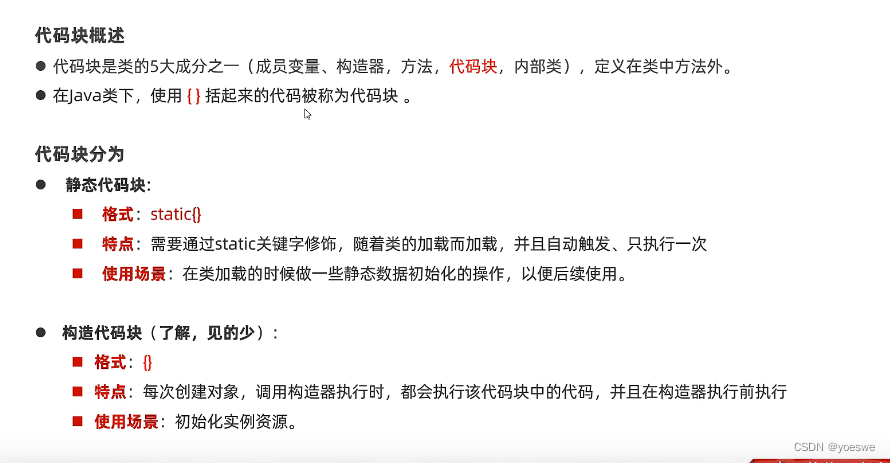static工具类:
package d2_static_method;
import java.util.Random;
//工具类
public class yoe {
/**
* 由于工具类无需创建对象,所以把其构造器私有化会显得很专业
*/
private yoe(){
}
public static String CreateVerifyCode(int n ){
//开发一个验证码
String code = "";
Random r = new Random();
String data = "abcdefghijklmnopqrstvuwxyzABCDEFGHIJKLMNOPQRSTUVWXYZ0123456789";
for (int i = 0; i < n; i++) {
//获取随机索引对应的字符
int index = r.nextInt(data.length());
code += data.charAt(index);
}
return code;
}
}实例:(数组的工具类设计)
package d2_static_method2;
//完成数组的工具类设计
public class ArrayUtil {
//私有构造器
private ArrayUtil(){
}
//工具方法:静态方法
public static String toString(int[] arr){
//1,一些校验
if(arr == null){
return null;
}
//2,拼接内容并返回
String result = "[";
for (int i = 0; i < arr.length; i++) {
result += (i == arr.length-1?arr[i]:arr[i]+",");
}
result += "]";
return result;
}
}
package d2_static_method2;
public class Test {
public static void main(String[] args) {
int[] arr = null;
int[] arr1 = {};
int[] arr2 = {1, 2, 3, 4};
System.out.println(ArrayUtil.toString(arr));
System.out.println(ArrayUtil.toString(arr1));
System.out.println(ArrayUtil.toString(arr2));
}
}
工具类可以节省代码的重复,当需要用时直接调用即可。
static 代码块:

package d3_static_code;
import java.util.ArrayList;
public class StaticDemo1 {
//静态资源
public static String schoolName;
public static ArrayList<String> cards = new ArrayList<>();
//静态代码块,有static修饰,属于类,与类优先加载一次,自动触发执行
//作用:可以用于初始化静态资源
static{
System.out.println("======静态代码块被触发执行了======");
schoolName = "yoe";
cards.add("3");
cards.add("4");
}
public static void main(String[] args) {
System.out.println("---main方法执行---");
System.out.println(schoolName);
}
}
package d3_static_code;
public class StaticDemo2 {
public StaticDemo2(){
System.out.println("===无参构造器被触发执行===");
}
//实例代码块(构造代码块),属于对象,每次构造对象是,都会触发一次执行(了解就行,很少用)
{
System.out.println("===实例代码块被触发执行===");
}
public static void main(String[] args) {
StaticDemo2 s1 = new StaticDemo2();
StaticDemo2 s2 = new StaticDemo2();
}
}实例:(模拟斗地主游戏游戏开始前的系统提前准备一副牌)
package d3_static_code;
import java.util.ArrayList;
//模拟游戏启动前,初始化54张牌数据
public class Static_Test {
//1:定义一个静态的集合,这样这个集合只加载一个,因为当前房间只需要一副牌
public static ArrayList<String> cards = new ArrayList<>();
//2:在程序真正运行main方法前,把54张牌放进去,游戏后续可以直接使用
static{
//3:正式做牌,放到集合中去
//a:定义一个数组存储全部点数:类型确定了,个数确定了(用数组存)
String[] sizes = {"3", "4", "5", "6", "7", "8", "9", "10", "J", "Q", "K", "A"};
//b:定义一个数组存储全部花色:类型确定,个数确定
String[] colors = {"♥", "♠", "♦", "♣"};
//c:遍历点数
for (int i = 0; i < sizes.length; i++) {
//d:遍历花色
for (int j = 0; j < colors.length; j++) {
String card = sizes[i]+colors[j];
cards.add(card);
}
}
//e:单独加入大小王
cards.add("小🃏");
cards.add("大🃏");
}
public static void main(String[] args) {
System.out.println("新牌:"+ cards);
}
}
static单例模式:

1:饿汉单例:
package d4_static_singleinstance;
//使用饿汉单例实现单例类
public class SingleInstance {
//2:饿汉单例是在获取对象前,对象已经提前准备好了一个
//这个对象只能是一个,所以定义静态成员变量记住
public static SingleInstance instance = new SingleInstance();
//1:必须把构造器私有化。
private SingleInstance(){};
}
package d4_static_singleinstance;
//目标:理解饿汉单例的设计步骤
public class Test {
public static void main(String[] args) {
SingleInstance s1 = SingleInstance.instance;
SingleInstance s2 = SingleInstance.instance;
System.out.println(s1 == s2);
}
}
2:懒汉单例:

package d4_static_singleinstance2;
public class SingleInstance2 {
//2:定义一个静态成员变量负责存储一个对象,只加载一次,只有一份
//注:这里不能new一个对象出来因为懒汉单例需要在用时创建,并且只能创建一次
private static SingleInstance2 instance;
//3:提供一个方法,对外返回单例对象
//注意:最好私有化,这样可以避免给别人挖坑,防止别人直接“.instance”
public static SingleInstance2 getInstance(){
if(instance == null)//当他没有时才创建
{
instance = new SingleInstance2();
}
return instance;
}
//1:私有化构造器
private SingleInstance2(){
}
}
package d4_static_singleinstance2;
//目标:掌握懒汉单例的设计,理解其思想
public class Test {
public static void main(String[] args) {
SingleInstance2 s1 = SingleInstance2.getInstance();
SingleInstance2 s2 = SingleInstance2.getInstance();
System.out.println(s1 == s2);
}
}
前几天摆烂了,今天继续。





















 175
175











 被折叠的 条评论
为什么被折叠?
被折叠的 条评论
为什么被折叠?








